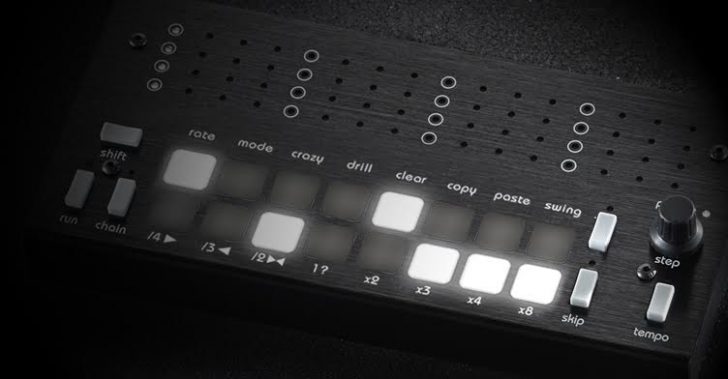Twisted Electrons is working on a follow up to their Crazy8 sequencer, Crazy8beats.
Crazy8beats follows the same general format as the Twisted Electrons Crazy8 sequencer and Acid8, but focuses on drum sequencing.
Features:
- 21 port connectivity (means 21 in- and outplut plugs)
- 2 MIDI OUT
- MIDI IN
- 8 triggers
- 8 cv outputs
- cv modulation per step (great for rhythmic effects)
- Midi CC per step or different notes per step
- Velocity
- Swing per Track
- probability and beat auto-remixing
- real time beat recording
- drill fx
- different clockrate per track (clockdivider / clockmultiplier per track – great for polyrhythmic madness)
- 16 patterns per track (can be changed per track or all at once)
- 87 blinkenlights
Pricing and Availability
We haven’t see any official announcement about the Crazy8beats on the Twisted Electrons site yet, but the new drum sequencer is expected to ship by Superbooth 2018, and be priced about the same as the Crazy8 sequencer (€255.00).
via Dr. Walker of Liquid Sky Berlin




Wow!!! Sounds like a monster sequencer for drums. Strongly triggers my “want have” button I hope they release more information soon…
I hope they release more information soon…
like the circuit: as long as there is no display i am not interested. i am actually somewhat baffled that lots of companies come up with halbaked gear that is way too cumbersome to work with. without a decent screen everything is crap imho, e.g., how would save and load things? how would you name things? i guess you understand my point. these tiny companies leave out basic functionalities due to costs. they don´t want to hire a coder. instead they want revenue the fast and easy way. to say it blundly, i´m sick and tired of this kind of business approach. instead of romanticizing soldering, they should follow the good example of isla instruments. their kordbot is not at all expensive and has a good display, plus a good firmware.
“Baffled” by drum machines with no screen?
Somehow, people managed to figure out ‘halfbaked’ gear like the 808 and 909 just fine.
lol
The absence of a display means that the designers can’t get lazy and bury the functions you really need under a maze of hierarchal menus. By not including a display you get assurance of a “flat” UI with everything you want readily accessible.
It makes for a bit of a learning curve on new gear, but when implemented properly a UI with no display can be way faster to work with. That means quicker compositions and more confidence when using it on stage!
No screen doesn’t mean more cumbersome; screens can be extremely cumbersome! Some functions on the circuit are incumbered by the lack of screen but many work great and most users would probably argue that overall it’s a smooth experience with a pretty shallow learning curve.
Also, hardware requires coding regardless of whether there’s a display, so being too “cheap” to hire coders is not the case.
The chordbot looks intriguing, but as far as I can see it’s a controller with some nifty chord memories, an arpeggiator and some other features, but it isn’t a polyphonic sequencer. Does anyone know if you can do more in the way of sequencing than personalising arpeggiator patterns on the chordbot?
It mentions velocity – I hope that means dynamic trigger outputs (and up to 10v please) this was the biggest failing of the Beatstep Pro.
Completely agree! Unfortunately it is considerably more costly and complicated, electronically, to make a bank of dynamic analog triggers – but it is absolutely essential for a drum sequencer.
Seems cool overall, but i never understood the point of probability settings on sequencers. To me they are a rather unmusical contraption, but maybe someone could explain this to me? I am genuinely interested in how people put it to use.
I love probability on sequencers, it lets you make sequencers that are much more interesting, because they don’t just repeat over and over.
For example, ‘ratcheting’ is a popular technique to make repetitive step sequences more interesting. If you’re doing an 8th note style sequence, just add a 16th note on the second half of the step and set it to trigger a small percentage of the time. Instantly, the sequence is more interesting.
Think humanizing with occasional fills or riffs. For drums, you might throw in occasional ghost notes or cymbals. For melodic sequences, you might throw in occasional blue notes or leading notes. It’s a simple way of making the machine improvise a bit.
Probabilistic parameters are amazingly powerful and can really bring something new to modern music to the point where one could argue they are giving rise to an entirely new genre of contemporary experimental music.
The features you are referring to are NOT that though. The only thing they really do is mask a maddening lack of arranging and compositional effort. Modern popular music production wants easy, quick and to-the-point tools meant mostly to mimick what was successful last month or last week. Great to throw together a quick techno set for half drunk audiences already deafened anyway by the abysmal creative void of mainstream entertainment, but almost useless for the crafting of actual pieces of music.
Forced ranting and joking aside, you guys know what I mean.